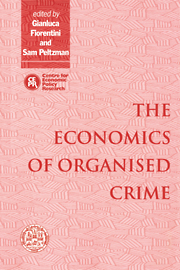Book contents
- Frontmatter
- Contents
- List of figures
- List of tables
- Foreword
- Acknowledgements
- List of conference participants
- 1 Introduction
- PART I THEORIES OF THE STATE AND THE ORIGIN OF CRIMINAL ORGANISATIONS
- 2 Organised crime, mafia and governments
- Discussion
- 3 Gangs as primitive states
- Discussion
- PART II THE CRIMINAL ORGANISATION AS A FIRM
- PART III ORGANISED CRIME AND STATE INTERVENTION IN THE ECONOMY
- PART IV DETERRENCE POLICIES AGAINST LEGAL FIRMS INVOLVED IN ILLEGAL ACTIVITIES
- PART V DETERRENCE POLICIES AGAINST ORGANISED CRIME
- Index
2 - Organised crime, mafia and governments
Published online by Cambridge University Press: 04 August 2010
- Frontmatter
- Contents
- List of figures
- List of tables
- Foreword
- Acknowledgements
- List of conference participants
- 1 Introduction
- PART I THEORIES OF THE STATE AND THE ORIGIN OF CRIMINAL ORGANISATIONS
- 2 Organised crime, mafia and governments
- Discussion
- 3 Gangs as primitive states
- Discussion
- PART II THE CRIMINAL ORGANISATION AS A FIRM
- PART III ORGANISED CRIME AND STATE INTERVENTION IN THE ECONOMY
- PART IV DETERRENCE POLICIES AGAINST LEGAL FIRMS INVOLVED IN ILLEGAL ACTIVITIES
- PART V DETERRENCE POLICIES AGAINST ORGANISED CRIME
- Index
Summary
Introduction
The mafia in Italy is an economic, social and political problem of considerable magnitude. Of this there is no doubt. Most striking is the murder of two anti-mafia crime-fighters in 1993, following the earlier murders of anti-mafia government officials, which demonstrates the willingness of the mafia to use violence and intimidation at the highest levels.
The term ‘mafia’ has been adopted internationally, most recently in the countries of the former Soviet Union. Russians refer, for example, to the Red Mafia. Economists prefer to talk about organised crime, but a mafia is more than a criminal gang willing to use violence and implies more than criminal activity that happens to be organised. Even a small criminal group, such as a gang that robs banks, has some organisational structure; someone drives the getaway car and someone else rides shotgun. Violence and some division of labour, or even a relatively elaborate organisational structure with positions that may be vacant and need to be filled, do not describe a mafia. The term is not applied to terrorist groups.
An organised criminal group engaged in illegal market activity – drugs, illegal liquor, gambling – is more likely to warrant the use of the term mafia. One of the critical features of such activity is that arrangements and agreements are made among participants that are not legal contracts. To go beyond personal relationships in which deals are completed at face-to-face meetings, participants need some larger structure or organisation that is able to enforce agreements and punish or redress violations thereof.
- Type
- Chapter
- Information
- The Economics of Organised Crime , pp. 33 - 53Publisher: Cambridge University PressPrint publication year: 1996
- 8
- Cited by



